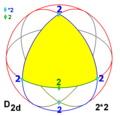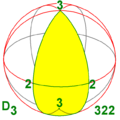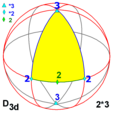Top Qs
Timeline
Chat
Perspective
List of spherical symmetry groups
From Wikipedia, the free encyclopedia
Remove ads
Finite spherical symmetry groups are also called point groups in three dimensions. There are five fundamental symmetry classes which have triangular fundamental domains: dihedral, cyclic, tetrahedral, octahedral, and icosahedral symmetry.
This article lists the groups by Schoenflies notation, Coxeter notation,[1] orbifold notation,[2] and order. John Conway uses a variation of the Schoenflies notation, based on the groups' quaternion algebraic structure, labeled by one or two upper case letters, and whole number subscripts. The group order is defined as the subscript, unless the order is doubled for symbols with a plus or minus, "±", prefix, which implies a central inversion.[3]
Hermann–Mauguin notation (International notation) is also given. The crystallography groups, 32 in total, are a subset with element orders 2, 3, 4 and 6.[4]
Remove ads
Involutional symmetry
There are four involutional groups: no symmetry (C1), reflection symmetry (Cs), 2-fold rotational symmetry (C2), and central point symmetry (Ci).
Remove ads
Cyclic symmetry
There are four infinite cyclic symmetry families, with n = 2 or higher. (n may be 1 as a special case as no symmetry)
Remove ads
Dihedral symmetry
There are three infinite dihedral symmetry families, with n = 2 or higher (n may be 1 as a special case).
Polyhedral symmetry
There are three types of polyhedral symmetry: tetrahedral symmetry, octahedral symmetry, and icosahedral symmetry, named after the triangle-faced regular polyhedra with these symmetries.
Remove ads
Continuous symmetries
All of the discrete point symmetries are subgroups of certain continuous symmetries. They can be classified as products of orthogonal groups O(n) or special orthogonal groups SO(n). O(1) is a single orthogonal reflection, dihedral symmetry order 2, Dih1. SO(1) is just the identity. Half turns, C2, are needed to complete.
Remove ads
See also
References
Further reading
External links
Wikiwand - on
Seamless Wikipedia browsing. On steroids.
Remove ads






























